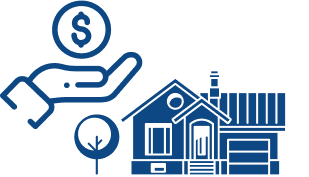Average Cost to Prepare a House for Sale: What Homeowners Really Pay Before Listing
November 19th, 2025 / Author: Cesar GomezPreparing your house for sale is a strategic process – one that can directly impact how much you walk away with, how fast the sale goes, and how much effort (and money) it takes. Selling a home isn’t just about waiting for the right offer; it often involves significant upfront costs.
In this blog, we’ll break down the average cost to prepare and fix up a house to sell, with expenses that are often overlooked and up-to-date figures, so you go into the sale with clear eyes, solid expectations, and no surprise bills down the line + smart options.
Why Preparation Matters
Selling a home isn’t just about putting a sign in the yard and listing it. Buyers want to feel confident in what they’re buying, and that means fewer visible problems, fewer questions, and a home that shows well. The process of getting a house ready for sale, if you're taking the traditional real estate route, includes everything from cleaning to staging, from minor repairs to major renovations.
If you skip too many of these steps, you risk a longer time on the market, lower offers, or needing to negotiate down the price. Industry data supports this. Home-selling costs in the U.S. average about 8–10 % of the home's sale price. So when you wonder: How much does it cost to prepare a house for sale?, be aware that it’s not trivial. This is why you should plan smart, knowing what not to fix when selling a house to minimize unnecessary expenses, and focus on what actually moves the needle.
- Major Repairs: Structural, Systems & Safety
Major pre-listing repairs might include roof replacement, HVAC issues, plumbing or electrical upgrades, foundation issues, mold remediation, or major structural fixes. These are pre-listing repairs that are obvious to buyers (or inspectors) and can act as deal-breakers after a home inspection if left unaddressed.
That's why it's no surprise that, according to the Joint Center for Housing Studies of Harvard University, despite small declines in 2023 and 2024, market spending for improvements and repairs is growing, supported by the continued aging of homes and households, as well as high levels of housing wealth.
So, what is the average cost to fix up a house to sell when it comes to major upgrades? While specific numbers depend heavily on region and property size, research shows that, on average, for sellers in 2025, pre- and post-listing repairs/improvements totaled around $21,024. If you take a smaller home and modest issues, you might spend in the low thousands; if you have deferred maintenance, costs can run tens of thousands or more.
- Roof repair/replacement: a partial roof repair might cost $1,000–$5,000, while a full replacement could go from $7,000 up to $30,000+ in some markets (depending on size and materials)
- HVAC system replacement: $4,000–$8,000
- Plumbing/electrical system updates: $2,000–$10,000
- Major structural repair: $10,000+
- Safety & code compliance: If there are code violations (e.g., missing handrails, noncompliant windows, fire hazards), you might spend a few hundred to several thousand dollars to bring things up to standard.
If you have a “fixer” home, this part of the preparation becomes the biggest chunk of cost and your budget. However, fixing major issues can significantly increase your home's market value and help you sell it. As a rule of thumb, allocate 1 % to 3 % of your home’s asking price toward improvements and fix-ups. So if your house is worth $500,000, that means $5,000 to $15,000.
Before listing, many homeowners opt for a pre-listing home inspection to identify potential deal-breakers ahead of buyer negotiations, which typically costs around $300–$500, depending on location and property size. Doing an inspection up front gives you more control and may save you from last-minute surprises when a buyer’s inspector points out issues later.
HUD’s National Standards for the Physical Inspection of Real Estate identify structural issues, system failures, and safety hazards as essential repairs that should be addressed before a home is sold.
- Minor & Cosmetic Repairs: The Little Things That Add Up
Not all repair costs are dramatic. Many will come from the small things that affect first impression, but nonetheless impact how buyers evaluate your home for sale and help them see renovation potential. These are the kinds of fixes that make the house “look good” rather than “fix broken systems.” They help with buyer perception and market appeal, and include:
- Interior painting (walls and trim)
- Flooring repair or replacement (carpet, wood, tile)
- Kitchen/bathroom minor updates (fixtures, cabinet paint, countertops)
- Fixing minor cracks, patching drywall, door/hardware replacement
- Exterior touch-ups (siding, gutters, exterior paint)
- Landscaping and curb appeal upgrades
If your home is in reasonably good condition, and you’re just doing fresh paint, cleaning, new carpet, maybe updating fixtures, you might budget $3,000–$10,000, depending on size and region. If the home has been neglected, the cost can quickly escalate. Even small repairs and cosmetic fixes can total a few thousand dollars, but they are often necessary to maximize your sale price or even attract buyers in the first place.
- Cleaning, Decluttering & Presentation
This is often the most overlooked area, but also one that yields a high return. A home that is clean, decluttered, and ready for showings sends a strong message to buyers. Before listing, neutral and spotless homes photograph better, show better, and often sell faster. Now, what about the cost of preparing the house for sale this way?
- Professional deep cleaning: $200–$500, depending on size
- Carpet cleaning or small carpet replacement: $800–$2,800
- Window cleaning: Inside and out windows significantly improve curb appeal — often $150–$400 depending on square footage and whether it's single or multi-story.
- Gutter cleaning, pressure washing, power washing: These services help refresh the exterior and could add another $200–$800, depending on house size.
Why does this matter? Buyers are visual. They walk in and make judgments, sometimes subconscious, about what condition the home is in and how much effort they’ll need to put in. If the home feels move-in ready, you gain credibility and possibly pricing power.

- Home Staging
One of the biggest differentiators in maximizing your home-sale profit is effective home staging. When done well, staging makes the home feel desirable, move-in ready, and lets buyers picture themselves living there. But how much does it cost to stage a house to sell?
- Average cost for staging in the first month is $1,500–$4,000, with additional months (if needed) running $150–$1,200 per month.
- There is often an initial consultation fee: professional stagers may charge $150–$600 to walk through and provide advice.
If your house is vacant, it can be more expensive: bringing in furniture, art, rugs, decor, etc., could run $4,000–$6,000+ for a fully staged, empty home.
Is it worth it?
Yes, especially in competitive markets. According to the National Association of Realtors (NAR), staging can increase buyer offers by 1–5%, and some sellers report even higher boosts, spending less time on the market and letting owners command higher home prices. If your home is already nicely furnished and you can DIY some staging, your cost might drop significantly.
- Landscaping and Curb Appeal
First impressions matter. What buyers see from the curb will influence whether they walk through the front door with positive energy - or suspicion. Typical costs involve:
- Basic yard clean-up, mulch, trimming: $500–$1,500
- Full landscaping makeover: $1,500–$3,500 or more.
Simple cleanup, lawn maintenance, planting flowers, trimming overgrown bushes, usually around $4–$12 per square foot, though this depends on your property’s size. Even minor landscaping investments before starting the home-selling process often pay off in perceived value and quicker offers because the home “looks cared for”.
- Marketing expenses & Listing Preparation
Beyond repairs and staging, you’ll incur costs around the listing itself:
- Professional photography and videography
- Drone shots (if appropriate)
- Flyers, brochures, print materials
- Online ad spend / boosted posts / MLS fees
These are often bundled into your listing or real estate agent fees, but if you're selling by owner (FSBO) or separately, you'll have to pay for these out of pocket. Marketing expenses may range from a few hundred to a few thousand dollars, depending on how aggressively you market the home. In 2025, marketing and staging averaged around $2,393 for sellers.
- Realtor Fees and Closing Costs
On top of the cost to repair a house for sale, you should also factor in the cost of selling the home itself, because these additional costs eat away at your profit, too.

Realtor Commission / Broker Fee
In most U.S. markets, the seller pays a realtor commission to the listing agent and the buyer’s agent. Typical listing fees average is 5–6 % of the sale price. So, for a $600,000 home, that’s $30,000–$36,000 in this fee at closing.
Closing costs, Title fees, Title insurance, Transfer Taxes
Beyond pre-sale prep, closing on a home involves several mandatory additional fees. This handful of costs associated with closing vary by state, but generally include:
- Seller closing costs: Tend to run 1–3% of the sale price (not counting agent commission)
- Title insurance fees: Often 0.5–1% of the sale price for the seller’s portion, especially if required in your state.
- Title search/title fees: Before closing, a title search confirms clear ownership, which costs around $100–$500.
- Recording fees, escrow fees, settlement fees: These vary by county, but typical recording fees are $125–$200, while escrow fees might be $350–$1,000.
- Real estate attorney: In some states or for complex deals, sellers may pay legal fees (e.g., $500–$3,000+).
- Transfer taxes and prorated property taxes / HOA dues: Depending on your area, this may add up further.
All of these often add up to 2–4 % of the sale price.In 2025, closing costs averaged $8,217 for many sellers.
Putting It All Together: A Sample Breakdown of the Average Cost of Selling Your Home
Here’s a ballpark breakdown to illustrate what a typical seller might spend to prepare and sell a $500,000 house in 2025:
| Cost Category | Estimated Cost |
|---|---|
| Major repairs (roof, systems) | $10,000 |
| Minor/cosmetic repairs (paint, flooring, fixtures) | $4,000 |
| Pre-listing cleaning | $300 |
| Landscaping / curb appeal | $2,000 |
| Home inspection / property survey + possible credits | $500 + $1,000 = $1,500 |
| Staging (first month) | $2,500 |
| Photography / marketing | $300 |
| Real estate agent commission (5.5%) | $27,500 |
| Closing costs (title, escrow, etc.) | ~2% = $10,000 |
| Seller concessions / hidden repairs | $3,000 |
| Moving (local) | $1,500 |
Total estimated cost: ~ $61,000 or about 12% of your sale price.
If you had fewer major repairs, you could bring this down. If you had deferred maintenance or luxury marketing, the number could go higher. That aligns with many home-selling cost estimates, which suggest sellers often spend 10–15% of the sale price when preparing and closing.
Hidden Costs to Watch Out for
Some home-selling costs are less obvious but still important to factor into your budget and the average cost to prepare a house for sale.
- Seller concessions: Sometimes, buyers demand credits or repairs after their inspection. These concessions can average 1–2% of the sale price.
- Home warranty: Some sellers offer a home warranty to buyers (to sweeten the deal), for which the pricing standard is around $300–$600.
- Deferred maintenance: Homes that haven’t been maintained cost much more to make show-ready.
- Market conditions: In a buyer’s market, you may need to invest more to stand out; in a seller’s market, you might get away with less.
- ROI of improvements: Not all upgrades yield equal returns. Some cosmetic updates give more value than expensive luxury remodels.
- Time on market: A house that isn’t prepared well may linger, which can cost you in interest payments, carrying costs, and possibly reduced offers.
- Other costs: Home inspection concessions, appraisal costs, possible repairs requested by buyers, moving costs, and storage costs.
- Tax implications: Capital gains tax may apply if your home isn't your primary residence or you exceed certain thresholds.
Making Decisions: How Much Should You Spend?
So, how do you decide how much to invest upfront in preparing your home?
- Calculate your equity and your time horizon: If you need to sell quickly (for relocation, financial changes, etc.), then you may not want to sink tens of thousands into prepping.
- Consider two “tiers”:
- Basic prep: Fix major deal-breakers, clean/declutter, paint, basic staging; aim at the lowest necessary spend.
- Full prep/turnkey: Address nearly everything, make home show-ready to attract premium buyers, potentially more investment but higher price.
- As-is sale: Minimal to no repairs, accept lower sale price, shorter time frame.
When selling As-Is Might Be the Smarter Move
Given how high the average cost to prepare a house for sale can be, many homeowners feel the pinch, especially if the property needs work or if they lack the time, energy, or cash to invest. That’s where direct cash home buyers like SleeveUp Homes offer a compelling alternative to sell your home as-is. If you want simplicity, minimal hassle, speed, and home-selling costs, this might be your best path forward. Selling a house as-is vs. fixing it up offers advantages such as:
- You don’t need to invest upfront in repairs, staging, or cleaning.
- You avoid multiple showings, delays, contingencies, and dealing with buyers’ inspection demands.
- You may close in days rather than weeks or months (helpful if you have a relocation, job change, or need cash fast).
- You skip the hidden costs of a prolonged listing.
- Improve and speed up your home-selling experience
For many homeowners, especially in Southern California, where real estate agent commission, staging, and closing costs can be especially steep, selling to a cash buyer eliminates a lot of the financial and emotional risk of preparing a home for the traditional market.
How It Works with SleeveUp Homes
At SleeveUp Homes, we buy houses across Southern California, in any condition, directly from homeowners. Here’s what we offer:
- No realtor commission or hidden costs.
- We cover all closing costs.
- No repairs, cleaning, or staging needed – you sell exactly as-is.
- We’ll beat any legitimate offer by $10,000.
- Need cash quickly? We can close in as little as 7 days, giving you liquidity fast.
- You avoid the time, stress, and cost of prepping, listing, showings, and repairs.
If you don’t have the resources—or the desire—to hustle through all the steps and costs to prepare your home for sale, this is a straightforward alternative. Unlike the traditional real estate route, where the costs can stack up, selling to us means no additional fee surprises.
Approach Your Sale Smartly
The average cost to fix up a house to sell is more than most homeowners realize. If you’re planning to sell your home, understanding the full scope of the cost to prepare a house for sale is crucial, and you’ll want to budget for all the pieces. A good baseline is planning for roughly 8–10 % of your home’s sale price, and in some cases up to 12–15 % (or more) depending on condition and market.
If you’re in Southern California and time, money, or stress are constraints, selling as-is to a cash buyer like SleeveUp Homes may be the smartest, simplest move. For homeowners who don’t want (or can’t afford) the upfront burden of preparing their home for market and jumping through all those hoops, but need to sell at a fair price, selling as-is for cash offers a powerful, quick, low-stress alternative.
Whatever path you choose: think ahead, budget realistically, and choose the route that aligns with your timeline, finances, and goals. If you’d like to get a personalized estimate for your home as-is, just say the word. Request a free cash offer today – no strings attached, and we'll make sure to offer a fair, realistic market price and make the home buying process fast and smooth.
SELL
YOUR HOUSE
If you want to sell fast and are worried about how long the traditional process takes, and the commission and fees involved, consider working with SleeveUp Homes.





 view all blogs by this author
view all blogs by this author Zachariah Peterson (69 blogs)
Zachariah Peterson (69 blogs)